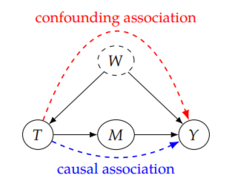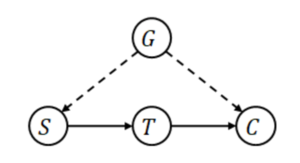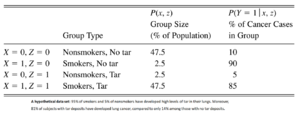前门调整
跳到导航
跳到搜索
调整目的: 因果效应估计
我们期望在给定如下因果图的情况下,判断治疗变量 T 对结果变量 Y 的因果效应 [math]\displaystyle{ P(y|do(t)) }[/math],其中 W 是一个未观测的混淆变量,M 是中介变量。(注意:我们现在观测不到W,无法进行后门调整.。)
主要步骤如下[1]:
- 估计T对M的因果效应[math]\displaystyle{ P(m|do(t)) }[/math] ,由于T-W-Y-M 这条路径被 阻断 (见 D-分离) [math]\displaystyle{ P(m|do(t))=P(m|t) }[/math].
- 估计M对Y的因果效应[math]\displaystyle{ P(y|do(m)) }[/math], 由于 T 阻断了后门路径 M<-T<-W ->Y, 根据后门调整 我们可以轻松得到[math]\displaystyle{ P(y|do(m))= \sum_t P(y|m,t) P(t) }[/math].
- 结合以上两种因果效应[math]\displaystyle{ P(y|do(t))= \sum_m P(y|do(m)) P(m| do(t)) }[/math].
前门准则[2]
定义:我们说变量集 M 关于 T 和 Y 满足前门准则,若:
前门调整
若变量集M关于(T,Y)满足前门准则,并且我们有[math]\displaystyle{ P(t,m)\gt 0 }[/math], T对Y的因果效应是可识别的,
[math]\displaystyle{ P(y|do(t))= \sum_m P(m| t) \sum_{t'} P(y|m,t') P(t') }[/math].
例子:吸烟与肺癌
- ↑ https://www.bradyneal.com/Introduction_to_Causal_Inference-Dec17_2020-Neal.pdf
- ↑ Pearl, Judea. "Models, reasoning and inference." Cambridge, UK: CambridgeUniversityPress 19 (2000).


